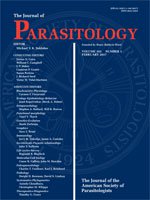Several trematode species infect the eyes of fish as second intermediate hosts. In most cases the definitive host is a piscivorous bird. Studies of a few species have shown an increase in transmission due to decreased visual acuity of the fish host. However, this may vary depending on trematode microhabitat choice within the eye. Some trematode species are found in the lens, some are found in the vitreous humor, and others have been reported from the retina. Here we report 3 genera of eyeflukes in 3 locations of the eye in the intermediate fish host, Gambusia affinis. Clinostomum metacercariae were found attached to the outer sclera within the eye orbit, and Diplostomum metacercariae were found in the lens. Posthodiplostomum metacercariae were confirmed by histology to reside between the choroid and pigmented retina. Posthodiplostomum metacercariae were found in both eyes of all 20 fish examined and in high intensities (up to 27 metacercariae per eye). High trematode intensities between the choroid and pigmented retina found in this study may disrupt vision in this fish host. Our study is the first to document the microhabitat of all 3 trematode metacercariae within the eye of G. affinis.
How to translate text using browser tools
1 February 2017
Microhabitat Selection and Eyefluke Infection Levels in the Western Mosquitofish (Gambusia affinis)
Shane L. Griffin,
Nichole Carpenter,
Autumn Smith-Herron,
Kristin K. Herrmann
ACCESS THE FULL ARTICLE

Journal of Parasitology
Vol. 103 • No. 1
February 2017
Vol. 103 • No. 1
February 2017




